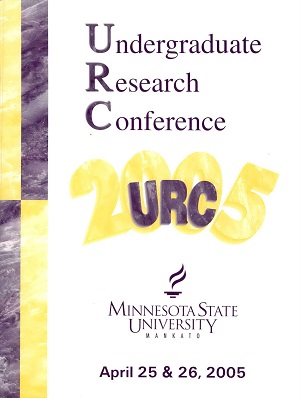Decomposition of a Native Grass Species in the Antartic Tundra
Location
CSU 255
Start Date
26-4-2005 10:00 AM
End Date
26-4-2005 12:00 PM
Student's Major
Biological Sciences
Student's College
Science, Engineering and Technology
Mentor's Name
Christopher T. Ruhland
Mentor's Department
Biological Sciences
Mentor's College
Science, Engineering and Technology
Description
We examined the decomposition of a native grass species (Deschampsia antarctica) using sizeselective litter bags in the Antarctic tundra. Litter bags were constructed of either 0.12 cm (small) or 1.2 cm (large) nylon mesh and placed on Bonaparte Point (64o46'S; 64o03'W) on Anvers Island along the western Antarctic Peninsula for approximately one year. Small litter bags excluded native herbivore invertebrates while large bags allowed invertebrates to access the plant material. We measured lignin, alpha-cellulose, holo-cellulose and total soluble carbohydrate and lipid concentrations of this material as well as changes in total organic carbon and nitrogen. Cellulose and lignin concentrations were high averaging 60 and 14.5% respectively, of the total dry weight of the plant material. Concentrations of soluble carbohydrates and fats averaged less than 1 and 5% respectively, suggesting rapid loss of these materials due to leaching. Decomposition rates averaged 58% for both small and large litter bags and did not significantly differ between mesh sizes. Our results suggest that invertebrate herbivores do not play a significant role in decomposition of the native grass species. In addition, decomposition of plant material was significantly greater in this wet maritime climate relative to drier inland areas of the Antarctic continent.
Decomposition of a Native Grass Species in the Antartic Tundra
CSU 255
We examined the decomposition of a native grass species (Deschampsia antarctica) using sizeselective litter bags in the Antarctic tundra. Litter bags were constructed of either 0.12 cm (small) or 1.2 cm (large) nylon mesh and placed on Bonaparte Point (64o46'S; 64o03'W) on Anvers Island along the western Antarctic Peninsula for approximately one year. Small litter bags excluded native herbivore invertebrates while large bags allowed invertebrates to access the plant material. We measured lignin, alpha-cellulose, holo-cellulose and total soluble carbohydrate and lipid concentrations of this material as well as changes in total organic carbon and nitrogen. Cellulose and lignin concentrations were high averaging 60 and 14.5% respectively, of the total dry weight of the plant material. Concentrations of soluble carbohydrates and fats averaged less than 1 and 5% respectively, suggesting rapid loss of these materials due to leaching. Decomposition rates averaged 58% for both small and large litter bags and did not significantly differ between mesh sizes. Our results suggest that invertebrate herbivores do not play a significant role in decomposition of the native grass species. In addition, decomposition of plant material was significantly greater in this wet maritime climate relative to drier inland areas of the Antarctic continent.




